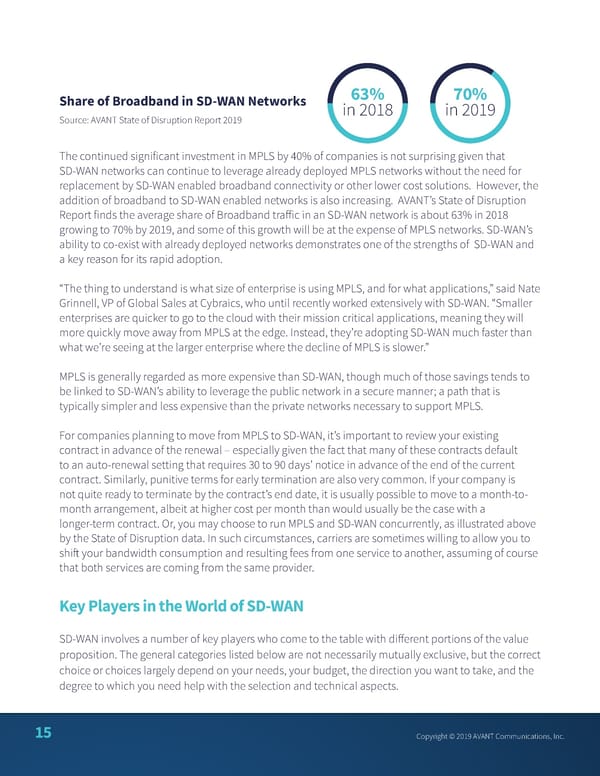Share of Broadband in SD-WAN Networks 63% 70% Source: AVANT State of Disruption Report 2019 in 2018 in 2019 The continued significant investment in MPLS by 40% of companies is not surprising given that SD-WAN networks can continue to leverage already deployed MPLS networks without the need for replacement by SD-WAN enabled broadband connectivity or other lower cost solutions. However, the addition of broadband to SD-WAN enabled networks is also increasing. AVANT’s State of Disruption Report finds the average share of Broadband traffic in an SD-WAN network is about 63% in 2018 growing to 70% by 2019, and some of this growth will be at the expense of MPLS networks. SD-WAN’s ability to co-exist with already deployed networks demonstrates one of the strengths of SD-WAN and a key reason for its rapid adoption. “The thing to understand is what size of enterprise is using MPLS, and for what applications,” said Nate Grinnell, VP of Global Sales at Cybraics, who until recently worked extensively with SD-WAN. “Smaller enterprises are quicker to go to the cloud with their mission critical applications, meaning they will more quickly move away from MPLS at the edge. Instead, they’re adopting SD-WAN much faster than what we’re seeing at the larger enterprise where the decline of MPLS is slower.” MPLS is generally regarded as more expensive than SD-WAN, though much of those savings tends to be linked to SD-WAN’s ability to leverage the public network in a secure manner; a path that is typically simpler and less expensive than the private networks necessary to support MPLS. For companies planning to move from MPLS to SD-WAN, it’s important to review your existing contract in advance of the renewal – especially given the fact that many of these contracts default to an auto-renewal setting that requires 30 to 90 days’ notice in advance of the end of the current contract. Similarly, punitive terms for early termination are also very common. If your company is not quite ready to terminate by the contract’s end date, it is usually possible to move to a month-to- month arrangement, albeit at higher cost per month than would usually be the case with a longer-term contract. Or, you may choose to run MPLS and SD-WAN concurrently, as illustrated above by the State of Disruption data. In such circumstances, carriers are sometimes willing to allow you to shift your bandwidth consumption and resulting fees from one service to another, assuming of course that both services are coming from the same provider. Key Players in the World of SD-WAN SD-WAN involves a number of key players who come to the table with different portions of the value proposition. The general categories listed below are not necessarily mutually exclusive, but the correct choice or choices largely depend on your needs, your budget, the direction you want to take, and the degree to which you need help with the selection and technical aspects. 15 Copyright © 2019 AVANT Communications, Inc.
 6 12 Report Research Page 15 Page 17
6 12 Report Research Page 15 Page 17